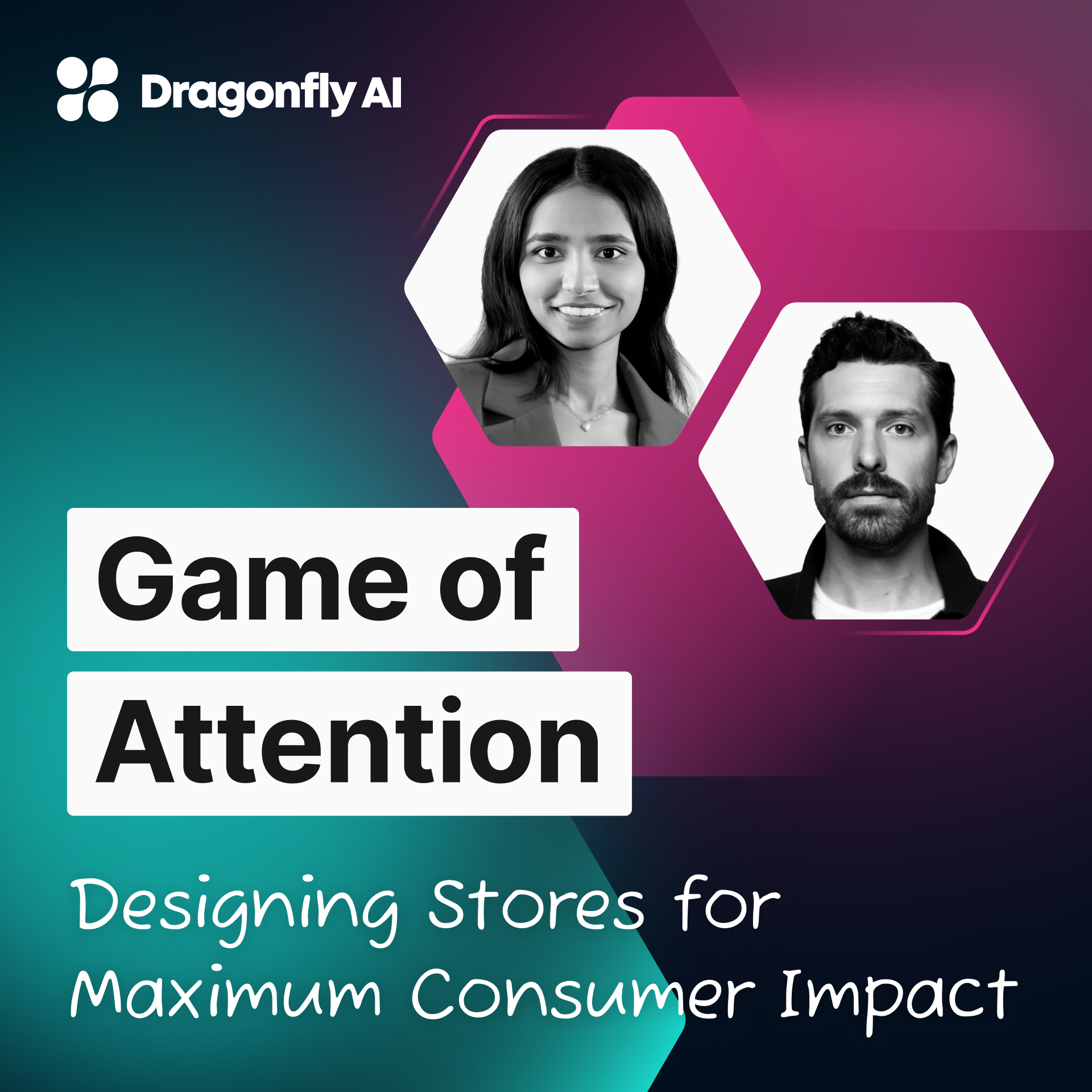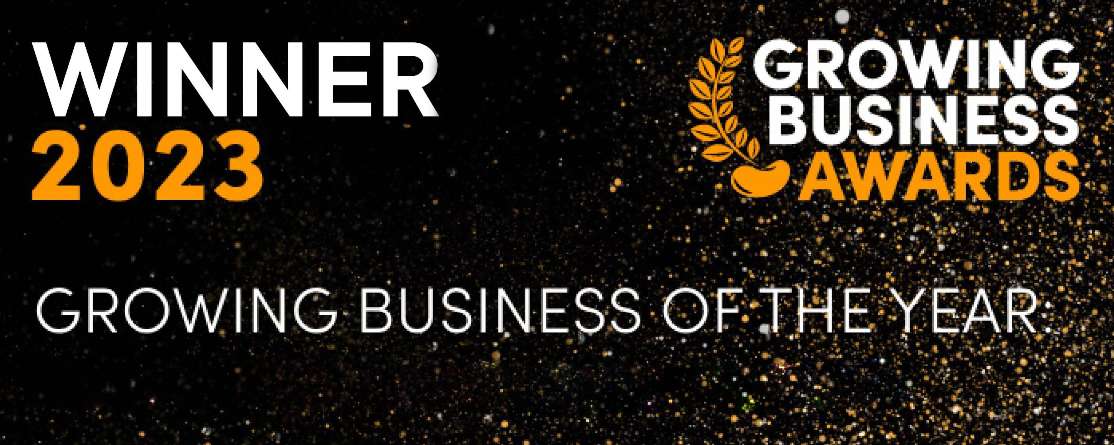Dragonfly AI is a predictive analytics platform designed to help you improve the quality and effectiveness of your creative across any format, channel and market.
Designing Stores for Maximum Consumer Impact
Expert-led podcast discussing trending articles, and news in the AI and attention spaces.

Webcasts led by experts
The layout of a store is critical to how a consumer behaves and shops. Psychology plays a substantial role in the different designs and uses.
In this episode, Ayesha Nathani, Global Store Designer at MAC Cosmetics, discusses how stores can strive for maximum consumer impact alongside Ryan McDaid, Head of Strategy at Mojo Supermarket.
Q: How did different store layouts such as grid and free flow designs impact consumer behavior and purchasing decisions?
Ayesha: The choice of store layout is a strategic decision that affects how consumers interact with this space, how efficiently they can shop, how they perceive the brand. Each layout is designed with specific goals in mind for maximizing product visibility, accessibility, creating a unique, engaging shopping experience.
Take an example of a supermarket that houses multiple categories of products under the same roof, which is likely to have more of a grid layout wherein they have parallel aisles housing various products which facilitates consumers to find their way around the store with minimal confusion. Customers can quickly locate items, follow a logical route through the store. This promotes like high turnover rate for products due to organized placements.
The free flow layout creates more of discovery, exploratory shopping experience. These types of layouts are often implemented when consumers are expected to wander around to discover products less predictably as opposed to the grid layout where it's like easy navigation.
Ryan: With any store layout, it always starts with what is the consumer's objective in going to a store versus just buying something off digital. think with the grid layout, it's used for routine shopping, the type of place where you know exactly what you're looking for and you almost have a pre -seated understanding of like where things generally are.
Supermarkets, big box retailers, like it follows sort of an innate understanding of, I need to get this thing. This thing is typically in this place and the store is oriented towards that.
I think that for free flow layouts, those are for more luxury experiences where the store is a destination for discovery, for entertainment. Sometimes it's social and it allows the consumer to explore.
Q: I'd love to ask you about what psychological tactics are used in store entrances to create positive first impressions and encourage deeper exploration?
Ryan: I think that every store, the entrance way sets the tone for the experience and it's an opportunity to pre-seed what the consumer's journey or what they're trying to purchase.
If you think about the mall, they're going to put things like products that are maybe of the season, there may be some scent or some display, something that pulls you in, drives your curiosity and tells you that something like this is deeper inside the journey. I think that for some stores, the immediate objective is to bring you in and create a sense of calm. You'll see a lot of retail and lifestyle stores bring you into sort of an open space where you're able to get oriented, you're transitioning into a new zone. There's lots of things for you to explore and they'll help you navigate and push you in certain directions for that.
Ayesha: Storefronts create the first impressions on the consumer shopping experience. I think providing wide, eye -catching entrances tend to encourage more consumers to explore the store further. Having appealing signages with graphics helps you draw customers inside of the store. It also communicates, I think, the brand's identity. An attractive entrance could also have tactics of clear signage, strategic lighting, well -lit displays, well -placed displays, interactive display, or a selfie point. Also, we also often try to use words like new or limited time offer, which could also like draw customers in by creating a sense of urgency.
Beka: In the UK, I believe they've just opened a couple of stores in America, Gymshark. They do a really good of drawing people in and they do that with a creating people that the consumers see themselves in.
Ryan: I was just in Seoul and we were doing a tour of some physical spaces and the brand that impressed me the most is Gentle Monster and Gentle Monster actually has three brands that are part of it. So Gentle Monster is the eyewear company and then they have Tamburin, which is their scent, fragrance, and then they have Nudake, which is their cafe and it's all experimental cafe food.
Each of these stores exist different in different spaces, but in certain areas they're combined into one structure. Each brand does a remarkable job of creating an entertainment and immersion experience that makes consumers at least want to stop by to see it and to photograph it, which then begins this journey of, okay, maybe I'll purchase something.
Ayesha: Agreed, like creating experiences wherein you can relate, like the brand can relate to the consumer, that impacts the consumer more.
Q: What future trends in retail spaces can we expect to see, especially concerning sustainability and ethical practices? I know this has been a massive, massive thing. Obviously, you've got all the ethical thing around the data collection and sustainability is obviously as hot as it's ever been.
Ayesha: These days both consumers as well as businesses have become more aware of like environmental and social impacts. We are shifting focus more to locally sourced upcycled recycled materials using reclaimed wood, recycled metals, glass, etc.
Designers also tend to design in a modular fashion. Design elements that can be reconfigured based on seasonal changes, promotional needs. This also would facilitate like reduction of waste with redesigns allows more efficient use of space, more efficient use of materials.
Ryan: While consumers aren't going out looking for stores that are, they're not making their decision of where they go based upon these things like sustainability and ethically sourced, but messaging those within the stores drives a sense of brand love and loyalty and can incentivize more purchase and a sense of this is a brand that aligns with my values. I want to shop here again. Brands like Everlane made their entire sourcing and their pricing very transparent, makes the consumer feel like I'm buying something that is fair, it's equitable, and it's a great price, and I want to continue to shop here because it aligns with my values. Also, Patagonia, they message that throughout their stores, and you feel as though this is a brand that is doing good in the world, and I want to be part of that journey. I think that those types of initiatives brands should be implementing them and then strategically messaging them. So where are you letting the consumer know where you're going to drive a deeper sense of loyalty and affinity?
Ayesha: I think if a consumer can personally relate to the story that the brand is telling and it makes them feel believable and that would go a long way because you need to prove to your consumer that you stand by these practices, you follow them through. I as a consumer would really go for brands which have like sustainable fashion ranges because I want to like upcycle my clothes.
Ryan: When brands dedicate square footage or footprint to showing their mission in action, it really goes a longer way than just messaging. If a brand is able to actually not just talk about it, but be about it, you're going to go a lot farther. I think about Patagonia doing repairs in their basement of the Soho store. If you go in and you have a damaged product, doesn't even have to be one of theirs, they will do mending, they'll redo zippers, they will refurbish the things that you have.
Ayesha: H&M would as we know it as a fast fashion brand, but then even that would consider offering discounts you take your old clothes and dump it in their bin, you are eligible for a 10 % discount. This also promotes a shopping experience for promoting the brand while promoting sustainability.
Q: What role do you think technology plays in creating effective, experiential retail environments and where should the line be drawn?
Ryan: Ayesha tapped into this earlier talking about the H&M example where the payment was seamless and being able to check out by just dropping all your clothes into a bin, it calculates it and it makes that process more frictionless and easier, I think is a best-in-class example of technology helping the shopping journey. I think anywhere where you're being asked to interrupt your real-life experience by pulling out your phone and engaging with it is a worst in class example. We don't need more barriers to purchase. We need technology to make it easier and more seamless.
Ayesha: As long as technology enhances the experiential moments for consumers that will be like more interactive, personalized, efficient experiences that would be helpful. As soon as technology creates barriers, that's when we want to stop. The usage of smart mirrors, virtual fitting rooms can be something we really need to try on because it saves time, helps consumers view items from different angles, need of physical try-ons is reduced, it enhances convenience. It is essential to strike a balance to ensure technological complements the human interaction, maintains user friendliness, respects privacy, avoids overwhelming consumers, then it would for sure enhance the overall experience.
Q: Could you summarize the most important things that a store can do for the maximum consumer impact What would they be like the top three things that every store should have to really have that that wow?
Ayesha: I would say starting with ease of shopping. It should be the first thing, ease. Second thing would be creating environment that complements the psychology of the consumer that we are targeting and not opposes it, I feel. The third would be storefronts attracting people in because you need to tell your brand story as quickly as possible as a consumer passes by.
Ryan: I was going to say even before you build brick and mortar or start to design, I think this question has to begin with at a brand level. So, what is, what is the lifestyle that our brand is here to add meaning and value to?
And how can we do that? Making sure that we understand the consumer mindset and the journey that they're going to be on. It's the consumer's journey, not the brand's journey.
How can we design to ensure that it's going to be as tailored to why they're coming here? And then I think the feeling, what's the feeling that you want this person to leave the store with? Do they want to feel more capable leaving Home Depot? Do they want to feel more creative leaving Apple?
Do they want to feel more environmentally connected leaving Patagonia? I think when you know what that feeling is, you can create an experience that executes that and makes people walk away really having a deeper relationship with the brand.
Don’t stop here – watch the full episode above or head to Spotify to listen to the full episode!
There are so many more nuggets from these fantastic guests. Not to be missed.
Subscribe here – new episode in 2 weeks!


